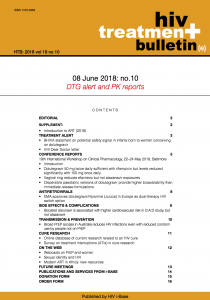08 June 2018: vol 19 no 10: DTG alert and PK reports
8 June 2018. Related: Editorial.
This issue of HTB continues the BHIVA treatment alert from the last issue, with additional documents relating to a potential signal for neural tube defects in babies whose mothers conceived on dolutegravir.
Both the BHIVA statement and the Dear Doctor letter from ViiV emphasise that no concerns have been seen in women who started dolutegravir during pregnancy. They add to similar statements from WHO and the US FDA and NIH. But, until further information becomes available recommendations follow a cautious approach.
We will include a commentary in the next issue looking at what is being done and what needs to be done to better understand this potential risk.
If anything positive can come from this, perhaps the Botswana data will serve as a call for better surveillance of new drugs. This should include well-resourced pregnancy cohorts with systematic collection of timing/infant outcomes and a comparator. After all there are a considerable number of women of childbearing age with HIV in need of ART across the world.
This issue also reviews other important research.
- First reports from the recent international PK workshop include postive reports on a paediatric dolutegravir formulation and dosing to overcome drug interactions with rifampicin.
- The dual fixed dose combination of dolutegravir/rilpivirine (Juluca) has received EU approval (and was launched in the UK).
- The D:A:D study reports higher risk of cardiovascular events associated with boosted darunavir (but not boosted atazanavir) that might contribute to the UK for adopting the US approach to primarily recommend integrase inhibitors as preferred first-line ART.
- And research on PrEP use in Australia, that has contributed to remarkable reductions in HIV incidence, has been complicted by research and media responses that are still preoccupied with reduced (and hioped for) reductions in condom use.
Finally, we highlight an excellent and comprehensive resource from Richard Jefferys that compiles and maintains a directory of more than 200 cure-related studies. Plus an online activist survey about how to maximise safety when this research includes treatment interruptions.
And On The Web links to new online resources that includes a set of resources from i-Base developed with TAC on modern ART in Africa.


